Anti-aircraft self-propelled installation Flakpanzer IV Wirbelwind (Germany)
In the new project it was proposed to implement several interesting ideas. The main idea of the project was to use a finished chassis with fairly high performance. The use of a tank chassis gave a number of advantages associated with the unification of various equipment, and also allowed the protection of the crew and weapons against a significant number of threats encountered on the battlefield. It was also proposed to equip the self-propelled gun quad installation with 20-mm automatic guns. Such systems in the towed version showed themselves well in the fight against low-altitude targets and could be good weapons for ZSU.
The project of a new anti-aircraft self-propelled began to develop at the very beginning of 1944 of the year. The project of a combat vehicle based on an existing tank was designated the Flakpanzer IV and the additional name Wirbelwind ("Smerch"). Creating such a machine did not take long. A new project provided for some re-equipment of the base tank and installation of the fighting compartment with new weapons. This approach to the design of the combat vehicle allowed to use as a base for the ZSU both the newly built serial tanks and the existing equipment undergoing repair.
In accordance with the Wirbelwind project, the Pz.Kpfw.IV tank had to lose the turret, instead of which it was proposed to mount a new similar unit with a different composition of equipment and weapons. Such an alteration of the tank did not require seriously modifying the hull, powerplant, chassis and other elements of the chassis. This made it possible to speed up the process of producing new equipment in the interests of the troops.
During the repair and modernization of the new project, the chassis retained the armor hull, which consisted of sheets of thickness up to 80 mm (depending on version). The reservation made it possible to protect the crew and the internal units from small arms during shelling from all angles, while the frontal projection could withstand the hitting of projectiles of some artillery systems. The layout of the hull was characteristic of the German tanks of the time. In front of the hull there were parts of the transmission, as well as the department of management with the jobs of the driver and the radio operator. The central part of the hull was given under the assembly of the crew compartment, and the engine was located in the stern.
By the time of the start of work on the Smerch project, new modifications of the base tank, differing from previous versions in some elements of the structure and power plant, were received for mass production. So, starting with the modification of Ausf.B, the Pz.Kpfw.IV tanks were completed with Maybach HL 120TRM petrol engines with HP 300 power. With the help of a propeller shaft, passing through the center of the hull, the engine was connected to the transmission of the front location. The main friction, five-speed (in later versions - six-speed) gearbox, a planetary steering mechanism and final drives ensure the rotation of the front drive wheels.
The chassis of the Pz.Kpfw.IV tank and the machines at its base had eight small diameter road wheels on each side. The rollers were connected in pairs on balancers equipped with leaf springs. The drive wheels were located in the front of the hull, guides - in the stern. Depending on the modification, the tank received three or four supporting rollers on board.
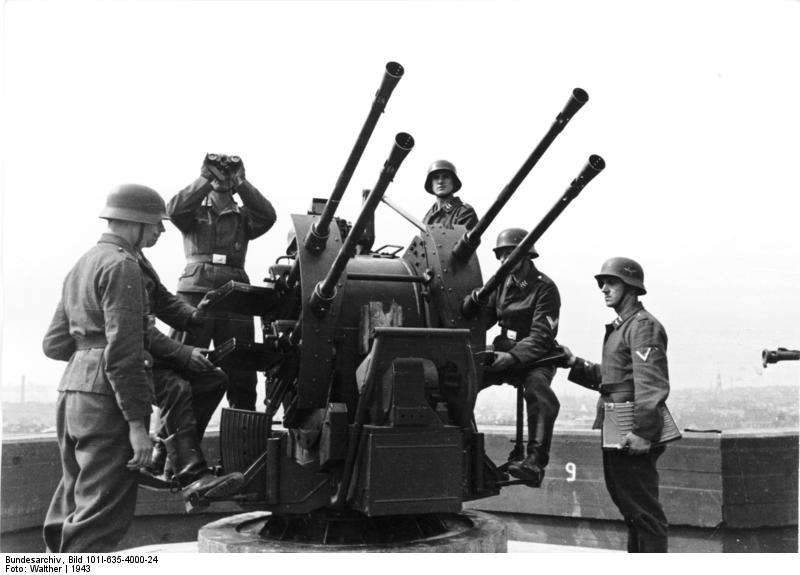
Quad installation 2 cm Flakvierling 38, used in the composition of self-propelled guns. Photo of Wikimedia Commons
The new anti-aircraft self-propelled project meant dismantling the base tank tower with weapons and other units of the existing combat compartment. Instead of the old tower, it was proposed to mount a new similar unit with anti-aircraft weapons on the chase of the hull. Inside the new tower should have been placed quadruple automatic guns and three crew members.
In view of the alleged use of technology at the forefront, the new Wirbelwind project implied the use of an armored tower capable of protecting the calculation of the guns from shelling from any angle, with the exception of the upper hemisphere. Based on the polygonal shape in contact with the shoulder strap, it was proposed to install several armor plates 16 mm thick, which were to form a polygonal tower without a roof. To improve protection and reduce the mass of the structure, the forehead, sides, and other parts of the turret consisted of two armor plates: the lower ones were installed with the collapse outward, while the upper ones leaned inward.
The new type of tower had a rather complicated shape. In front of the front sheets were provided at an angle to each other. They had large vertical slots to move the gun barrels. Relatively wide cheekbones, behind which small sides were located, were connected with the frontal sheets. The stern of the tower consisted of angled long panels and a narrow stern. The proposed design of the tower was to provide the required protection of the crew, as well as a relatively small mass. In addition, the requirements for the size of the units affected the shape of the tower: the armor elements of the tower, regardless of its position, should not have gone beyond the roof of the hull.
In the center of the tower was mounted quad installation 2 cm Flakvierling 38 with 20-mm automatic guns FlaK 38. The new project implied the use of some elements of the base carriage of this system. Thus, the attachments of the guns and their synchronization systems, the sight and the mechanisms of vertical guidance were preserved. It was proposed to perform horizontal alignment by rotating the entire tower with the help of appropriate drives. Initially, it was proposed to rotate the tower with the help of manual drives, which could provide guidance speeds of up to 28 ° per second. Serial "Tornado" late release received manual and hydraulic actuators. The latter increased the speed of rotation in azimuth to 60 ° per second. The gunner was able to fire in any direction with elevation angles from -10 ° to + 90 °.
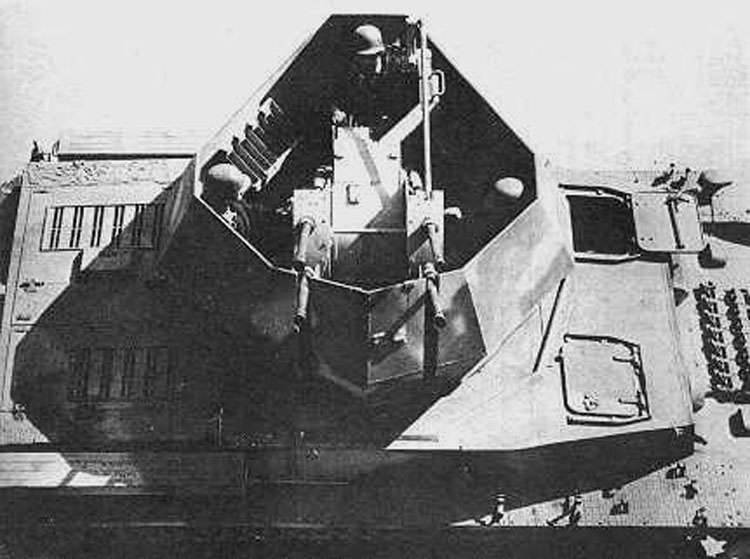
The layout of the tower. On the sides of the guns are charging, behind - the gunner. Photo Aviarmor.net
Installation Flakvierling 38 was a system based on four automatic guns FlaK 38. The guns had a caliber 20 mm and had to use shells 20x138 mm B of various types. Each of the four guns could do up to 400-450 shots per minute (technical rate of fire), but in practice, the rate of firing of the quad set did not exceed 750-800 shots per minute. The shells left the gun barrels at speeds up to 900 m / s and, depending on the type, could hit targets at ranges up to 2-2,2 km. All four cannons were fueled using separate box magazines on 20 shells.
The gun installation was mounted in the central part of the turret in such a way that inside the armored unit there was some free space for the placement of gunners and ammunition. Thus, the gunner should be located at the stern of the tower, managing the guidance systems and leading fire. Under the sides of the tower placed seats for two loaders. Shelves for stores included in ready-to-use ammunition were placed along the long aft parts of the sides.
The quad unit, located in the tower, made it possible to attack air and ground targets. Despite this, the car retained the additional armament used on the base model tank. In the workplace of the gunner-radio operator, in the front part of the hull on the right, there was a front embrasure with the MG34 machine gun, with which the crew could defend against enemy manpower.
Due to the dense and competent layout of the internal volumes of the ZSU hull, Wirbelwind had to carry a fairly large amount of ammunition. It was possible to transport several dozen stores with a total capacity of over 1300 shells and 3200 cartridges for machine guns.
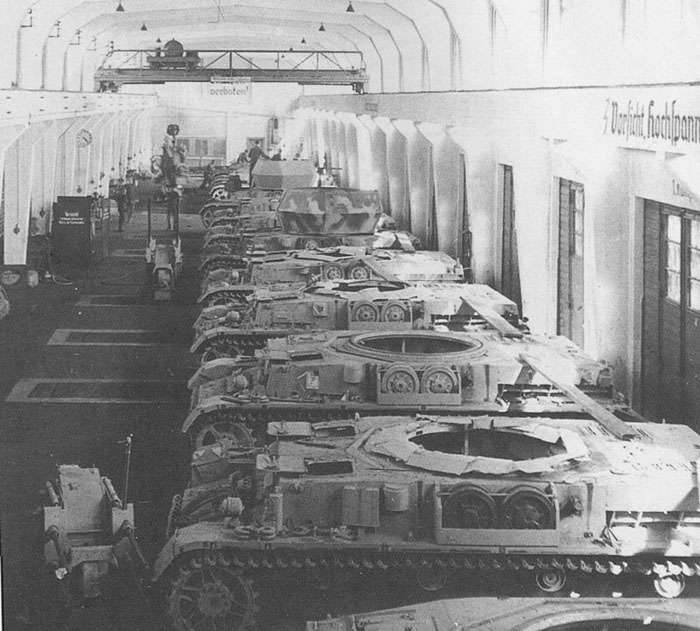
Construction self-propelled Flakpanzer IV at the factory Ostbau. Photo Aviarmor.net
The crew of the combat vehicle consisted of five people: the driver, radio operator, gunner guns and two loaders. The first two were to be located in the front of the hull, and the workplaces of the other three anti-aircraft gunners were placed in a rotating turret. At the places in the department of management should get through the hatches in the roof of the hull. Access to the gunner and charging places was carried out through the open top of the tower, which also improved visibility in a combat situation.
Due to the characteristic design of the turret, associated with specific requirements, the dimensions of the new combat vehicle generally remained at the level of the base tank. The length was approximately 5,9 m, the width of 2,9 m. At the same time, the height increased noticeably and was 2,76 m. The combat weight of the ZSU was determined at the level of 22 t. With such a mass, the 300-strong engine could provide a specific power of at least 13,6 hp per ton of weight, which allowed to maintain mobility at the level of the tank Pz.Kpfw.IV. The maximum speed reached 40 km / h, the range on the highway was 200 km.
The comparative simplicity of the project and the widest use of finished components allowed the development of the Flakpanzer IV Wirbelwind machine in a relatively short time. The construction of the first prototype also did not take much time. Already in May, the company Ostbau presented the first prototype of a promising anti-aircraft self-propelled gun for testing.
The tests of the first experimental machine clearly showed the correctness of the ideas underlying the project. Used tracked chassis gave the car a fairly high mobility, which allowed the "Tornado" to move along with the tanks, both in columns on the march and in battle formations. The use of a well-developed artillery system with sufficiently high characteristics also promised good combat effectiveness. As a result, the project was considered successful and recommended by the beginning of mass production.
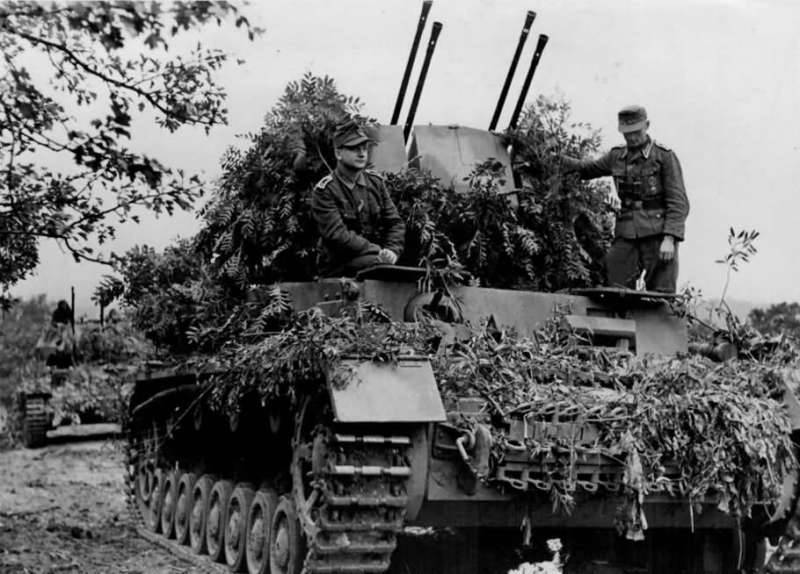
Self-propelled gun at the front. The machine received an improvised masking of scrap materials. Photo Worldwarphotos.info
Shortly after the completion of tests of the first prototype, the Ostbau plant received an order for the serial construction of new self-propelled guns. After adopting the new machine, the existing designations Flakpanzer IV and Wirbelwind, and also received a new Sonderkraftfahrzeug 161 / 4. Also in some sources there are other designations that reflect the types of the base chassis and the main armament.
The first serial ZSU new model was ready in July 1944 year. Soon the first batch of this technology was sent to the front. At about the same time, the Wirbelwind project encountered some difficulties, which largely determined its further fate. In the course of new research and analysis of combat experience, it was found that 20-mm automatic guns, even those assembled in quadruple installations, do not provide the required firepower sufficient to guarantee the solution of the assigned combat missions. Much more promising and effective weapon automatic gun caliber 37 mm looked. By that time, a ZSU with similar weapons existed - 3.7 cm FlaK auf Fahrgestell Panzerkampfwagen IV (sf) or Möbelwagen.
In connection with the appearance of new requirements regarding the firepower of anti-aircraft self-propelled guns, the industry has begun to develop completely new projects of such technology. The existing Smerch did not fully meet the requirements of the military, but its construction continued. In view of the expectations of new self-propelled guns with 37-mm guns, it was decided to leave the existing equipment in production and use it as a temporary solution in anticipation of more advanced systems.
Production of self-propelled Wirbelwind was completed in November 1944 year. In just a few months, at least 86 machines of this type were built on Ostbau. Exact information about the number of built machines is not available: figures from 86 to 106 units are given in different sources. Anyway, the pace and volume of production of new equipment left much to be desired and did not allow for the full re-equipment of ground forces anti-aircraft units.
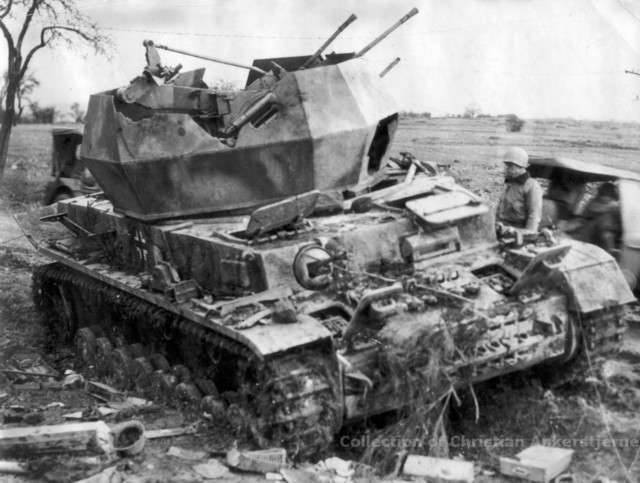
One of the Wirbelwind self-propelled guns that fought and destroyed on the Western Front. Photo Panzerphotos.com
According to reports, the vast majority of new anti-aircraft self-propelled guns were transferred to units that fought on the Eastern Front. According to different sources, they were given armored vehicles up to 85-90. The remaining equipment, no more than 15-20 units were sent to Western Europe. Detailed information about the combat use of this technology in two theaters of military operations is not available. There are fragmentary data on the successful use of self-propelled guns in repelling enemy raids, as well as on the use of this technique as a means of infantry fire support.
A number of Smerches became trophies of the enemy. So, it is known that several of these machines in the final stages of the war went to the Red Army. The Soviet fighters limitedly applied this technique and spoke of it as a good means for firing at the enemy, entrenched on the upper floors of buildings. Also, a certain amount of ZSU became the trophies of the Allies, who were advancing on the Second Front.
Part of the Flakpanzer IV Wirbelwind self-propelled guns could have survived until the end of World War II, but later almost all of the remaining copies were disposed of as unnecessary. Only two anti-aircraft self-propelled guns of this type have survived to our time. Both cars at the time were taken to America for testing and evaluation. Subsequently, one of them was transferred to the Museum of the Borden Base (Canada), and the other for some time was an exhibit of the museum in the Aberdeen Proving Ground. Later it was transferred to the military history museum in the city of Kiel (Germany), where it is kept to this day.
The fate of the project self-propelled anti-aircraft installation Wirbelwind is very interesting. It was created as the embodiment of a promising and promising proposal concerning the combination of chassis and weaponry. In the early stages, the project received good marks and had a lot of support from the army. However, by the time the tests began, the German military was disappointed in the 20-mm automatic cannons and preferred 37 mm guns to them, resulting in the launch of alternative projects. As a result, it was possible to build only a little more than a hundred ZSU with quad units, which could not have a serious impact on the course of the battles. New projects, in turn, led to the construction of self-propelled guns with increased firepower, but an additional result was the dispersal of forces, which in the end did not allow the army to be equipped with a sufficient amount of necessary equipment.
On the materials of the sites:
http://achtungpanzer.com/
http://aviarmor.net/
http://armor.kiev.ua/
http://t-34.su/
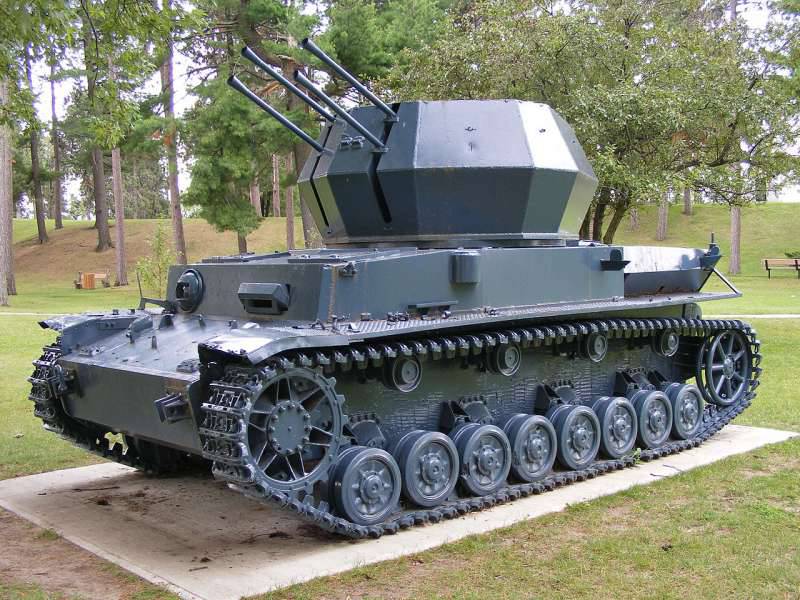
Information